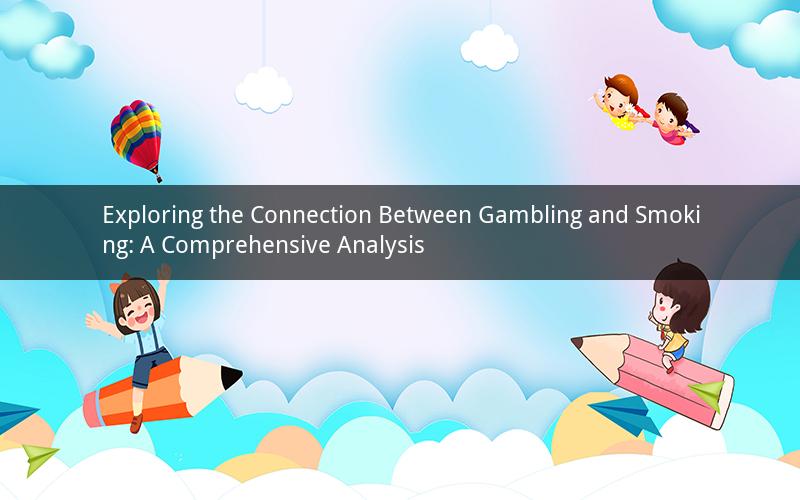
Introduction:
The relationship between gambling and smoking has been a topic of interest for researchers and enthusiasts alike. While both activities are considered addictive, the connection between them remains a subject of debate. This article aims to delve into the existing literature and explore the potential link between gambling and smoking, discussing various aspects such as the psychological and physiological factors involved.
1. Understanding the Addictive Nature of Both Activities:
Gambling and smoking are both addictive behaviors that can have severe consequences on an individual's health and well-being. The addictive nature of these activities is rooted in the release of dopamine, a neurotransmitter associated with pleasure and reward. Both gambling and smoking trigger the release of dopamine, leading to a reinforcing effect that can make individuals crave these activities more frequently.
2. Shared Risk Factors:
Several risk factors have been identified as common to both gambling and smoking. These include impulsivity, sensation-seeking behavior, and a history of substance abuse. Individuals who exhibit these risk factors may be more susceptible to developing an addiction to both gambling and smoking.
3. Psychological Factors:
The psychological factors contributing to the connection between gambling and smoking are multifaceted. One significant factor is the presence of stress and anxiety. Individuals who engage in both activities may use gambling and smoking as coping mechanisms to deal with stress and anxiety. Additionally, the psychological reinforcement of rewards and successes in gambling may lead individuals to seek similar rewards through smoking.
4. Physiological Factors:
The physiological aspects of the connection between gambling and smoking are also worth exploring. Both activities have been found to affect the brain's reward system, leading to changes in neural pathways. This can result in a heightened sensitivity to rewards and an increased risk of addiction. Furthermore, the use of nicotine in smoking can exacerbate the addictive nature of gambling by reinforcing the desire for both activities.
5. Social and Environmental Factors:
Social and environmental factors play a crucial role in the connection between gambling and smoking. Individuals who have access to both gambling and smoking opportunities may be more likely to engage in both activities. Additionally, social influences, such as peer pressure and the normalization of these behaviors, can contribute to the connection between gambling and smoking.
6. The Role of Advertising and Marketing:
Advertising and marketing strategies have been identified as influential factors in the connection between gambling and smoking. Both industries have been known to employ similar tactics, such as using glamorous and exciting imagery to promote their products. This can create a synergistic effect, where individuals who are attracted to the allure of gambling may also be drawn to smoking.
7. The Impact on Public Health:
The connection between gambling and smoking has significant implications for public health. Both activities can lead to a range of negative health outcomes, including cardiovascular diseases, respiratory problems, and mental health issues. Understanding the connection between these activities can help in developing effective interventions and prevention strategies.
8. Intervention and Treatment Approaches:
Addressing the connection between gambling and smoking requires a comprehensive approach to intervention and treatment. This includes identifying and addressing the underlying risk factors, providing support for individuals struggling with addiction, and implementing policies that restrict access to both activities. Treatment approaches may involve cognitive-behavioral therapy, motivational interviewing, and medication-assisted treatment.
Questions and Answers:
1. How does the release of dopamine contribute to the connection between gambling and smoking?
Answer: The release of dopamine, a neurotransmitter associated with pleasure and reward, plays a crucial role in the connection between gambling and smoking. Both activities trigger the release of dopamine, leading to a reinforcing effect that can make individuals crave these activities more frequently.
2. What are some common risk factors shared by individuals who engage in both gambling and smoking?
Answer: Common risk factors shared by individuals who engage in both gambling and smoking include impulsivity, sensation-seeking behavior, and a history of substance abuse. These factors make individuals more susceptible to developing addictions to both activities.
3. How can stress and anxiety contribute to the connection between gambling and smoking?
Answer: Stress and anxiety can contribute to the connection between gambling and smoking by serving as coping mechanisms. Individuals may turn to both activities as a way to deal with stress and anxiety, leading to a reinforcing effect and an increased risk of addiction.
4. What role do social and environmental factors play in the connection between gambling and smoking?
Answer: Social and environmental factors, such as access to gambling and smoking opportunities, peer pressure, and the normalization of these behaviors, play a significant role in the connection between gambling and smoking. These factors can create a synergistic effect, making individuals more likely to engage in both activities.
5. How can interventions and treatment approaches address the connection between gambling and smoking?
Answer: Interventions and treatment approaches can address the connection between gambling and smoking by identifying and addressing underlying risk factors, providing support for individuals struggling with addiction, and implementing policies that restrict access to both activities. Treatment approaches may involve cognitive-behavioral therapy, motivational interviewing, and medication-assisted treatment.